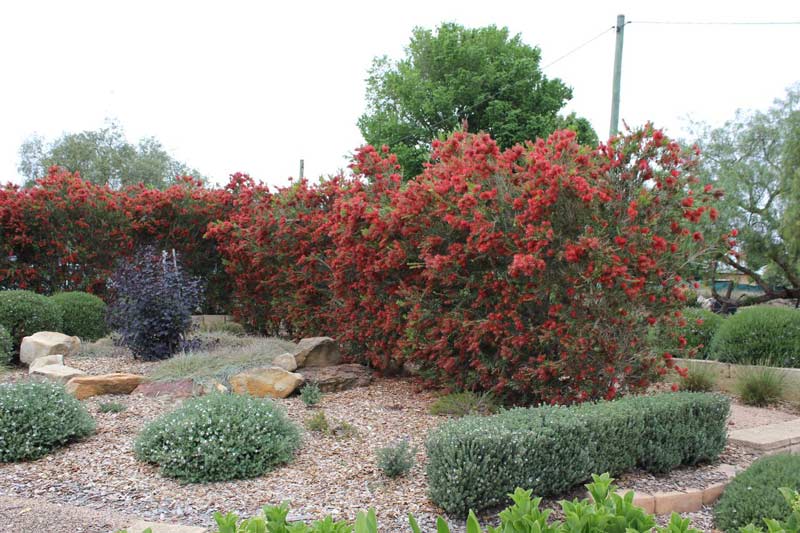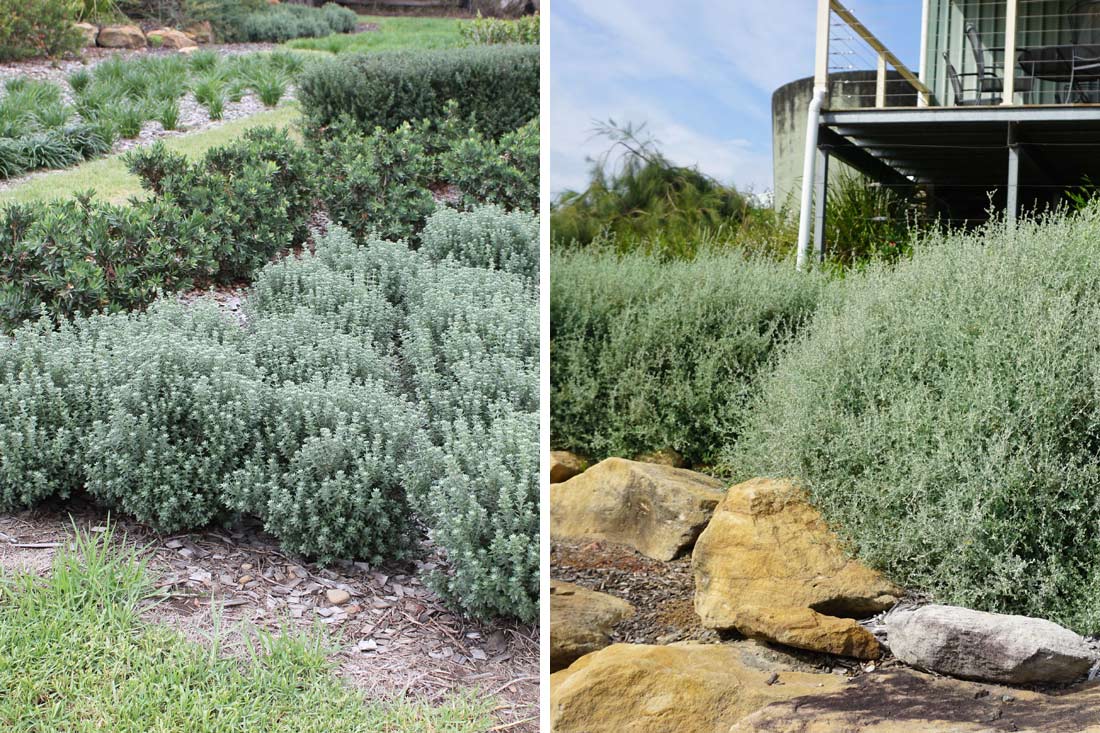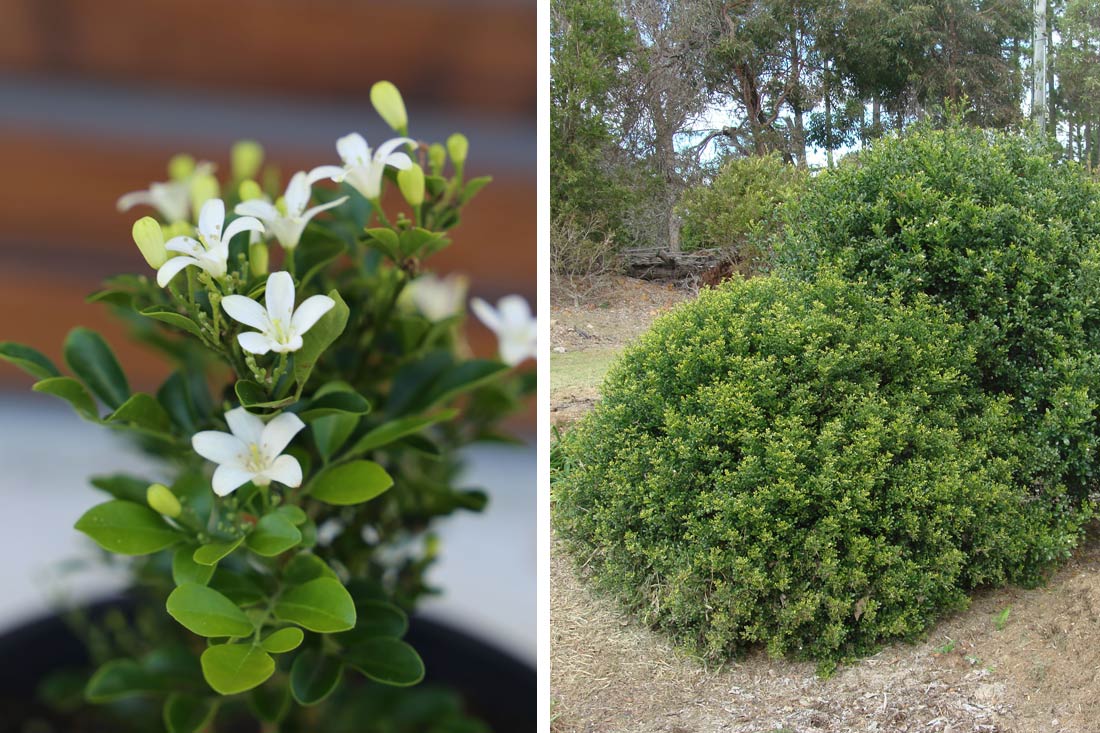Introduction
Are you looking for the perfect native screening plants that not only provide privacy but also support local pollinators? Native Australian plants are increasingly favoured by gardeners for their ability to thrive with minimal intervention, making them ideal choices for sustainable gardening. By selecting hardy native cultivars, you can create a garden that is not only visually appealing but also beneficial to local wildlife.
This article highlights five excellent screening plants which are distinguished by their unique growth habits and resilience, providing effective privacy screens while enhancing your garden’s biodiversity. You’ll see screening plants that bloom from early spring right through to late winter, so you won’t have any gaps throughout the year.

Slim™Callistemon is a real show-off in spring.
Why Choose Native Plants for Your Garden?
Native plants are a cornerstone of sustainable gardening, offering numerous benefits to both the gardener and the environment. However, I don’t want you to get caught in the trap I see a lot of gardeners fall into, which is a mentality of “native = good, exotic = bad.”
In natural ecosystems, we want to preserve the endemic plant communities which have existed for at least thousands of years, because the native fauna have nuanced relationships with each plant. However, urban conditions have changed so much – the soils are different, the plant communities are different, and the activities going on are different. The existence of loud noises, roads, people walking about, builders dumping subsoil on top of the topsoil are all examples of how urban ecology has changed, and we need to change our mindsets to adapt to these changes.
Some native fauna have adapted well to the urban environment, like possums, rainbow lorikeets, and many native bees. Meanwhile, others do not thrive in urban environments, such as numbats, bell birds and a number of specialist butterflies and moths.
You may have heard people argue that we should only be planting locally native (endemic) plants, but this doesn’t line up with what I’ve observed in my 10+ years as a maintenance gardener and horticulturist. A blend of exotic, native and endemic plants is great, especially when we can cater to generalist pollinators throughout each of the four seasons (even though you could argue Australia doesn’t conform to the European concept of four seasons – but that’s a topic for another day).

Natives are great! Especially when they flower like this Naringa™ Westringia, which is super attractive to bees, birds, butterflies and moths. (I think this one’s a butterfly because of the way the wings fold)
Sure, there are specialist pollinator-plant relationships, and I encourage you to learn about the specific endemic plants local to your region which can support these fragile populations. However, by simply planting diversely and densely, you can achieve much better results than if you are very picky or think you can recreate natural ecosystems in the urban environment.
The main reason I like to choose Australian native plants is because I’m a proud Australian, and I reckon we have the best plants in the world. I don’t necessarily believe they’re better for wildlife in urban areas than exotic plants, as the most popular plant for pollinators in my own garden is a toss-up between a native Australian Callistemon, and an exotic Duranta, native to the Americas.
Biodiversity Resources
Plants play a role in the ecosystem by supporting local pollinators, such as bees, butterflies, and birds. These pollinators are essential for the reproduction of many plants and the production of seeds and fruit. Those seeds and fruit are then food sources for other fauna.
It’s not just about food, though. Plants also provide habitat through their thick shrubbery. Consider leaving dead wood and hollows for certain types of fauna.
Plants can also enhance the soil health and prevent erosion through their well-established root systems. This contributes to a more stable garden environment and reduces the need for chemical inputs, which can harm beneficial soil organisms and pollute waterways.
Spring Flowerers
Spring is a time of year when most insects start to build up their numbers. This could start before September; often halfway through Autumn in warmer climates you’ll notice spring-flowering plants bud up and pollinators start buzzing in larger numbers. It’s important to make sure you support pollinators early in the season to set them up for success throughout the whole year.
Slim™Callistemon viminalis ‘CV01’ PBR
Distinctive Features and Resilience
Slim™ Callistemon is renowned for its narrow growth habit and is an excellent choice for creating a vibrant hedge. With its compact form, it fits perfectly into tight planting areas where space is limited. It is also phyophthora and myrtle rust-resistant, which are two of the biggest killers.
Cultivation and Maintenance
To ensure Slim™ Callistemon thrives, it should be planted with adequate spacing to accommodate its mature width, ensuring good air circulation. Position it in full sun for optimal flowering and growth. Regular pruning will not only maintain its desired shape but also promote the health and vigour of the plant. This can be done annually after flowering to keep the hedge dense and lush. Mulching and the application of a slow-release fertiliser in spring will further bolster its growth.
Attracting Pollinators
The vibrant red bottlebrush flowers of Slim™ Callistemon are a magnet for pollinators. Their striking appearance and abundant pollen and nectar supply attract birds, bees and other pollinating insects, providing crucial resources throughout spring when flowers are abundant, and continuing with sporadic flowers throughout most of the year.

Naringa™ Westringia hybrid ‘WES01’ PBR
Distinctive Features and Growth
Naringa™ Westringia stands out as one of the best medium-tall hedging plants available, appreciated for its rapid establishment and tidy form. This westringia variety reaches a height of 2.2 metres and a width of 1.5 metres when left unpruned, making it a perfect choice for creating a robust privacy screen. It boasts masses of mauve flowers in spring, and sporadic flowering throughout the rest of the year. With a naturally tidy growth habit, this plant requires less frequent pruning compared to other westringia types, making it a low-maintenance choice for gardeners.
Cultivation and Care
To thrive, Naringa™ Westringia prefers full sun to partial shade and can adapt to various soil types, from sandy to reasonably well-drained clay soils. This plant tolerates cold and drought, but it’s important to avoid planting in areas with poor drainage. A well-mulched garden with chunky mulch and seasonal use of slow-release organic fertiliser will ensure optimal health.
Attracting Pollinators
Naringa™ Westringia not only enhances garden aesthetics but also plays a role in supporting local pollinators. Its flowers attract bees and other beneficial insects, as well as birds, with its valuable source of nectar and pollen. Flowers are most abundant in spring, but are sporadic throughout much of the year.

Summer Flowerers
Once the spring-flowerers have slowed down a bit, it’s time for the summer-flowerers to take over. The weather’s still warm and pollinator activity is still in full swing.
Straight and Narrow™ Syzygium australe ‘SAN01’ PBR Intended
Characteristics and Growth Habits
Straight and Narrow™ Syzygium is another exemplary choice for those looking to install a slim, effective screen in their garden. This variety of lilly pilly is noted for its slender, semi-compact growth habit, making it ideal for tight planting areas. An outstanding feature is its resistance to psyllid, a common pest that can afflict many other lilly pilly varieties, ensuring a healthier, more robust plant. It’s quite forgiving with the amount of sunlight it receives, but will display more flowers in full sun.
Planting and Care Tips
To optimise growth, plant it in a location that receives full sun to partial shade. It prefers moist, well-drained soils, and benefits from regular watering during the initial 8 to 13 weeks post-planting to establish a strong root system. Pruning is ideal for maintaining its shape and density; perform this task twice a year for a neat hedge or every two to three years if you prefer a wider screen display. Alternatively, coppice it to the ground every few years.
Attracting Pollinators
Its white flowers are a delightful attraction for generalist pollinators such as birds and bees, providing them with valuable nectar and pollen in summer. Following the flowering period, the plant produces vibrant pink to red fruit, which can attract birds and other wildlife.

https://www.ozbreed.com.au/plant-ranges/native-shrubs-groundcovers/straight-and-narrow/
Sweeper® Waterhousea floribunda ‘DOW20’ PBR
Key Features and Appearance
Sweeper® Waterhousea is a striking example of natural elegance, renowned for its heavily weeping form and lush foliage. This advanced tree or giant screen variety is characterised by its dense growth and rippled leaves, creating a graceful cascading effect. It produces large clusters of white flowers in the summer, adding seasonal beauty to its already impressive appearance. Notably, this tree is highly resistant to myrtle rust, making it a robust choice for a variety of garden settings.
Planting and Care Guidelines
Sweeper® Waterhousea thrives in full sun to part shade, favouring well-drained to heavy clay loams. It is well-suited for regions that experience cold and occasional drought, though it should be avoided in hot or dry exposed inland areas. This tree grows to a height of 10 metres, with a spread of 5 to 8 metres, making it ideal for large spaces. Pruning every 2-3 years helps maintain its shape and density.
Attracting Pollinators
Sweeper® Waterhousea displays flowers in summer which attract various pollinators like birds and bees, followed by berries which further support local biodiversity.

Autumn and Winter Flowerer
As the weather cools, pollinator numbers start to die back a bit. However, many insects (and certainly birds) are still active throughout the cooler months, so it’s still important to provide pollination resources. By including winter-flowerers, you provide an early resource to help build pollinator populations up at the very beginning of “spring.”
Coastal Pink™ Correa alba ‘COR10’ PBR
Unique Characteristics and Adaptability
Coastal Pink™ Correa, a variation of the popular Correa alba, is renowned for its pink flowers and strong growth habit, making it a versatile medium shrub or hedge. This correa naturally forms a dense, bushy structure reaching 2 metres in height and width, offering a substantial barrier against coastal winds. Its adaptability makes it an excellent choice for coastal landscapes, providing both visual interest and resilience in challenging conditions.
Growing and Maintenance Tips
This correa thrives in full sun to light shade and prefers well-drained soils, although it can adapt to a variety of soil types as long as they don’t stay wet. It is drought and frost-tolerant, and loves a bit of pruning once or twice a year to maintain a semi-compact form and encourage a tidy appearance. Fertilising with a slow-release organic fertiliser aids in its growth and flowering potential.
Attracting Pollinators
Coastal Pink™ Correa’s vibrant flowers are not only eye-catching but also attract local wildlife, including birds and bees.

Practical Considerations for Gardeners
Choosing the Right Plant for Your Space
When deciding between each of the plants mentioned, consider the specific conditions of your garden, and decide which plant fits best. Evaluate the available space, soil type, and climate conditions. For example, Straight and Narrow™ Syzygium and Slim™ Callistemon are ideal for narrow spaces needing a vertical screen, whereas Naringa™ Westringia and Coastal Pink™ Correa are a bit shorter and wider. Slim™ Callistemon can tolerate periodic wet feet, while the others cannot.
Enhancing Your Garden’s Biodiversity
To further support pollinators and enhance garden biodiversity, consider companion planting with other native species that offer staggered flowering times, including smaller shrubs and ground covers. This approach ensures a continuous supply of nectar and habitat for pollinators.
Conclusion
Incorporating native Australian screening plants into your garden can provide the dual benefits of privacy and ecological support, while also speaking to our love for Country. These plants not only offer practical solutions for space constraints but also play a vital role in sustaining local wildlife. By choosing these native options, you contribute positively to your local environment, creating a sanctuary for pollinators and other beneficial creatures.





